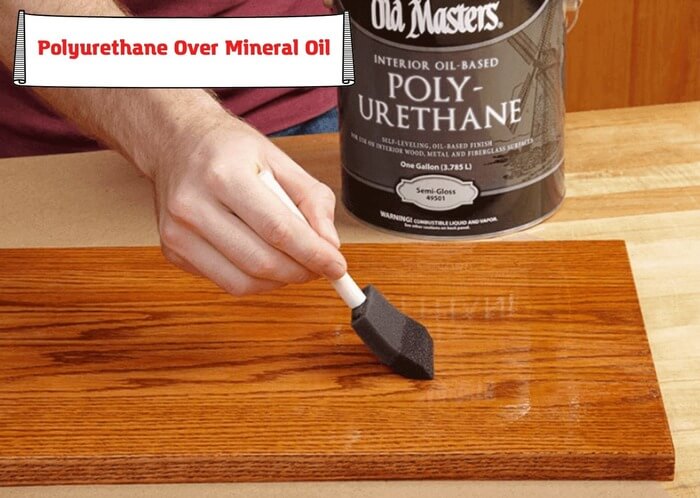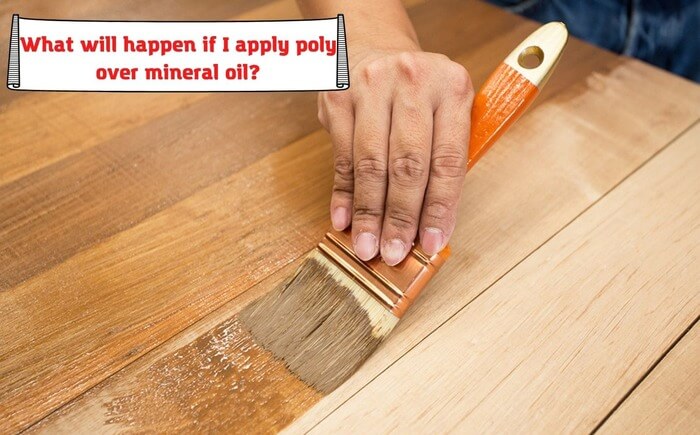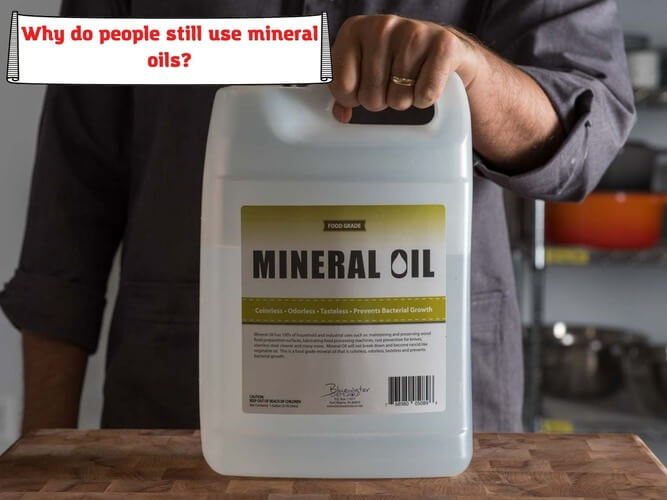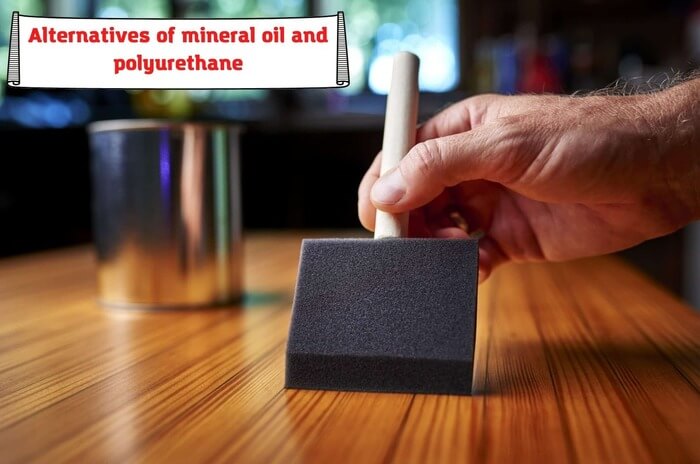
Mineral oils are often said to be the greatest way to protect your wood project and to make it look natural. Though not all projects are good with all those mineral oils because they are greasy and they don’t ever dry. So when it’s about a piece of wood you use for decoration and never touch, it’s OK. But if it’s about a table or a shelf, you will probably want to recoat the project with something just to get rid of all those negative effects of mineral oil.
The first thought that might spring into your mind is polyurethane. This is a product that cures well, ensures wonderful protection, and still looks really good. We recommend using polyurethane in all cases when it’s appropriate. But what about a project that already has some mineral oil on it? The question is too controversial and it will take some time to answer.
So, in our today’s article we’ll discuss such topics:
- Poly over mineral oil – is it possible at all?
- What will happen if I apply polyurethane over oil?
- Water- or oil-based polyurethane?
- How to clean off all the mineral oil from wood?
- What are the pros and cons of polyurethane?
- What are the pros and cons of mineral oils?
- What alternatives of poly over mineral oil can you get?
Let’s get started!
Is it possible to put polyurethane over mineral oil?
No, it’s not possible because any mineral oil won’t dry completely. It will always be greasy and sticky, it won’t be a decent base for applying any other topcoat, especially polyurethane. Usually, wood craftsmen don’t need to apply any other topcoat on top of mineral oil. They use oils to stain and protect the wood when it’s appropriate.
So before choosing any mineral oil that doesn’t dry, be sure to read some specifications of the product you are going to use. This will help you avoid any problems in the future.
What will happen if I apply poly over mineral oil?

As you already know, mineral oil doesn’t dry completely no matter how long you wait. Because of this, the oil doesn’t make a good base for any other materials including varnishes. Though, there is one lifehack we know, and we’ll tell you about it in the next sections of our article.
So, if you apply poly over mineral oil, you won’t get any good results. Polyurethane will peel off and won’t cure as it should. Even if some spots cure, they will not ensure proper parameters of the topcoat.
What about oil-based polyurethane?
You may have heard a myth that water-based poly is a bad idea to apply over mineral oils that don’t dry, but oil-based polyurethane will do well because it may be based on the same oils that you used for your project before. But actually, it doesn’t work like that. Both water-based and oil-based poly types won’t do well.
You will have some chances to apply oil-based polyurethane after special preparations. But sometimes those preparations will take more time than working with a new project of the same type. So, it’s hard to say if it’s worth your time and effort for some projects.
What top coats can you apply over mineral oil?
You have to understand that mineral oils are usually topcoats. They never dry so they are good for protecting your wood from all kinds of damages and aging. Though sometimes we want to remaster some wooden objects or we suddenly change our minds in terms of wood finish. And in this case, you may try to find out which finish you can use over mineral oil.
One possible option is shellac. You shouldn’t clean off all the oil from the wood surface if you are going to use shellac. What’s more, you can apply polyurethane after shellac cures. This is the answer to your question – you can apply poly over mineral oil if you have shellac as your intermediate agent. But let’s face it, the quality of the finish won’t be as good as you may expect it to be.
If you want a really good finish, you will need to clean off as much mineral oil as possible. This will help you prevent any troubles in the future.
Steps to clean off mineral oil from wood
- Take any mineral spirits, naphtha, acetone, or other materials that can help you dissolve mineral oil and wipe it off your project.
- Apply acetone (or any liquid you have chosen) and wait for a couple of minutes to let it work on the surface.
- Take paper towels or soft cloths (better paper towels so you can throw them away once they absorb some oil.
- Continue wiping off oil until you see that the surface is nearly clean.
- Take sandpaper with different grit levels and sand your wood to clean off even more mineral oil.
- The last sanding should be conducted with 600-grit sandpaper to ensure that you don’t leave any scratches and damages left.
- Wait for some time so that some leftovers of oil can dry at least partially.
Preparing your wood for other finishes
After you have cleaned off enough oil, you can apply other finishes like polyurethane, shellac, or other types. We would go for poly as it’s an all-purpose finish material that looks good and protects the wood surface from numerous damages and problems.
Here are the tips to prepare your wood that can still contain some mineral oil:
- Ensure that the wood is clean and dry. Use your hand to check if there are no problems that need to be corrected.
- Use mineral spirits to clean the wood surface. This prep method will help you remove all dust, grease, and other contaminants that may disturb poly from curing properly.
- Take oil-based polyurethane only. If you have a risk of some mineral oil on your wood, better use oil-based poly. Otherwise, your finish won’t dry.
- Read the instruction on the package of your product. Some manufacturers give great tips that will help you prolong the lifespan of the finish.
The final list of steps in wood prepping will depend highly on the type of product you choose. The key in this situation is to remember that your wood can have some leftovers of mineral oil. Remember that mineral oils penetrate the wood grains and they are impossible to wipe off completely. That’s why using something like water-based polyurethane is a very bad idea in this case.
Why do people still use mineral oils?

You may think that mineral oils are the most food-safe materials you may find among wood finishes. But that’s not completely true. Mineral oils aren’t 100% natural, they contain some chemical elements and components that may make them toxic, too. Also, a lot of other oil finishes for wood are even better for food surfaces.
So why do people still use mineral oils? They actually have some advantages:
- they are relatively stable under high temperatures;
- they ensure the most natural look and clear finish;
- they are less toxic than many other finishes for wood;
- they are safe to apply, no fumes and no odors take place.
Though, mineral oil isn’t that long-lasting. These types of finishes need to be reapplied from time to time so that they look good. And we know many wonderful alternatives to mineral oils that can make your wood project look even better and still be protected against any problems and damages.
What are the main pros of polyurethane?
Polyurethane is a more modern choice. You can use poly on nearly any surface. But remember that polyurethane finish is completely safe after it’s cured. It takes around 30 days for polyurethane to cure completely. It doesn’t mean that it will be wet for 30 days, just don’t put any food on it before a month has gone.
So, here are the pros of polyurethane:
- it dries and hardens completely which is a very good point for choosing poly;
- it’s really durable compared to any other known wood finishes;
- it can resist heat, moisture, chemical damages, physical damages;
- smooth results are guaranteed, the design will be great;
- relatively simple application with many options to apply poly.
Polyurethane is a very popular choice that can make your wood project look much nicer than you can expect. This is a very good option for those who want to ensure their wood project looks good for a long time. And it’s also safe once it’s completely cured. Yes, poly will need some protection for a craftsman during the application, some toxic fumes will form there in your room.
What are the alternatives of mineral oil and polyurethane?

Please bear in mind that not all natural oil types are mineral oils that are appropriate for wood. By saying ‘mineral oil’ we mean the kind of specially prepared oil that contains mostly organic components in it. This oil is still a chemical product that may contain a lot of additives.
Obviously, you would go for mineral oil when you want to stain or just protect some surface that comes in contact with food. And so we decided to offer some decent alternatives.
If you want to know some alternatives to use, here they are!
1. Beeswax
This is an all-natural product that is thought to be the best option for any food surface made of wood. Well, we don’t consider it best, but many craftsmen say it is. The reason is simple – it’s natural, clean, easy to apply. But it’s not very long-lasting, so you will need to reapply it even more often than mineral oil. So we would skip this option and look at some others.
2. Walnut oil
Again, a natural product that is known to be polymerized after application. And this is a good feature that helps walnut oil live much longer. This oil will stain the wood and will offer a great way to make it look better. Some cons are obvious: this oil is hard to clean off and reapply when you want.
3. Linseed oil
Not a bad option as it dries and allows you to use any other finishes over it. Linseed oil is very popular among food-safe finishes. But please remember that you will need to wait for a month before putting any food onto the surface. Linseed oil is known to be quite affordable and it’s really simple to apply, too.
4. Tung oil
This is another great option that is quite natural and doesn’t contain any harmful chemical components after it cures. Tung oil still has many disadvantages and one of them is the price. This oil is made mainly in Asia and is exported to other countries which makes it more expensive than you can expect.
5. Shellac
It’s also one of the best options you can get. But this one will require a lot of effort when applying. Shellac is hard to apply evenly and smoothly, so you will spend a lot of time sanding it off and applying once again to get a decent result. Especially, if you are a beginner in woodcrafts. But in the end, shellac will give you both, great design and wonderful durability.
Final words
You should avoid using lacquers or cooking oils for your wood finish. Lacquers are chemical products that aren’t food-safe. If you don’t want to poison anyone, it’s better to avoid using lacquers on any wood surfaces that may come in contact with food. It’s also a bad idea to use cooking oils because they won’t dry and will bring all the problems of mineral oils without protecting your wood much.
In the end, we want to say that using mineral oils is not the best method to ensure a great finish for your projects. You should think of alternatives. But if you have already applied some mineral oil, you better forget about the idea to cover it with polyurethane. Poly won’t cure and will peel off very fast. Look at great alternatives you can get at fair prices.
- Can You Unmix Paint: Techniques, Consequences, Alternatives - February 23, 2024
- Does Primer Need to be Mixed? Effective Primer Application - February 22, 2024
- How to Make Old Paint Usable Again: Retrieving and Preserving Paint - February 21, 2024



